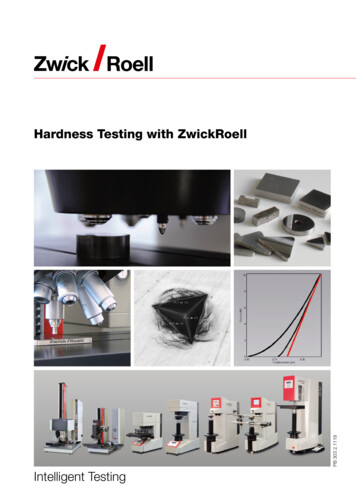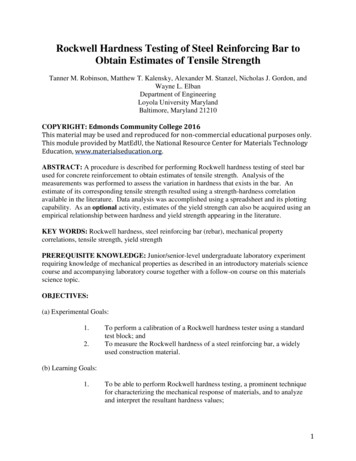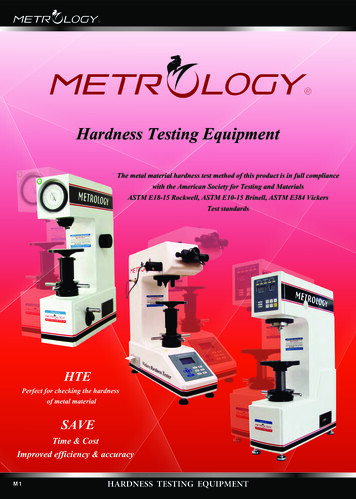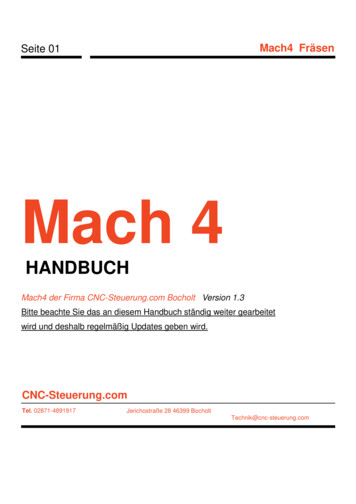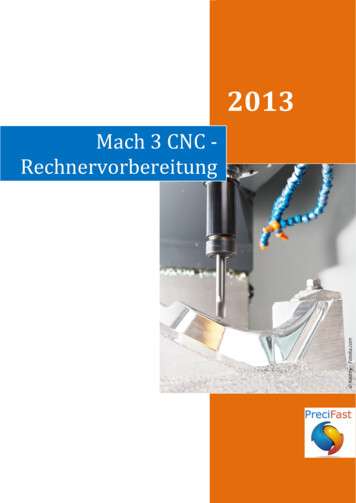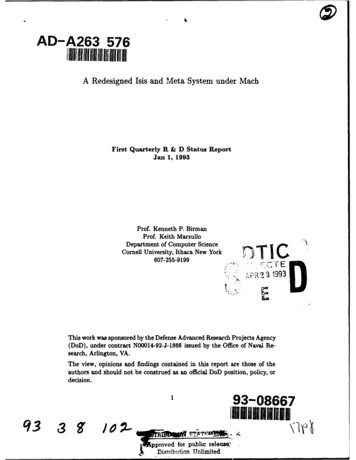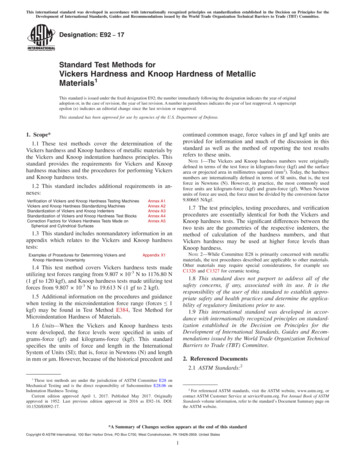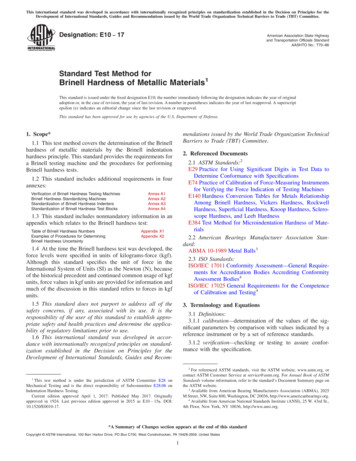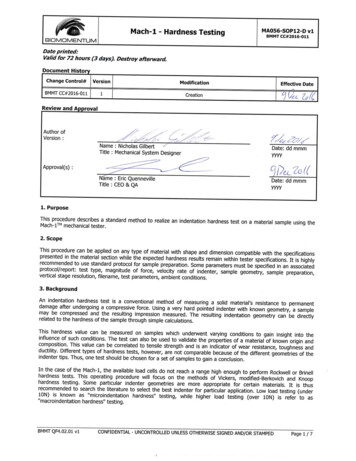
Transcription
MA056-SOP12-D v1Mach-1 - Hardness TestingFigure 1. Vickers Indenter (ASTM C1327-15, 2015)BMMT CC#2016-011Figure 2. Knoop Indenter (ASTM E384-16, 2016)In the case of a Vickers hardness test, a square-based pyramidal diamond tip indenter is used to transfer a constantforce for a specified dwell time. The resulting indentation diagonals are measured to obtain the Vickers hardnessnumber (HV). The modified-Berkovich is a 3-sided triangular based pyramid with the same projected area as Vickers.For a Knoop hardness test, a rhombus-based pyramidal diamond tip is used in the same manner. The resulting longindentation diagonal is measured to obtain the Knoop hardness number (HK).General equation for these methods:𝐻𝑎𝑟𝑑𝑛𝑒𝑠𝑠 𝑣𝑎𝑙𝑢𝑒 𝑇𝑒𝑠𝑡 𝐿𝑜𝑎𝑑𝐴𝑟𝑒𝑎 𝑜𝑓 𝑖𝑚𝑝𝑟𝑒𝑠𝑠𝑖𝑜𝑛Testing Considerations: It is important that the resulting indentation is symmetric, measurable and repeatable.The perpendicularity of the sample surface to the indenter as well as the surface finish of the sample are importantfactors in obtaining valid hardness results. The presence of large cracks, asymmetry and coincidence with pores arefactors that could invalidate a result. Thus, multiple tests must be evaluated to obtain a statistically relevant result.Large enough indent diagonals are desired for high measurement precision ( 20 μm). Since the applied force isdirectly related to the size of the indent, a large enough force is also desired ( 25 gf).When producing a set of results for comparison, the methods (load, dwell, rate) and test type (Vickers, Knoop, etc.)should remain constant.Table 1. Some literature’ parameters and reference values.ReferenceSample MaterialBaldassarri et al.,2008Bartlett et al.,2004Beniash et al.,2010Farina et al.,2012Note: HV (VickersDental enamel inratsDental enamel inmiceOyster shellsIndenterForce (gf [N])Dwell time (sec)Vickers100 [0.98]5Knoop10 [0.098]10Vickers50 [0.49]5Hardness ResultAcrylic resins forVickers25 [0.25]30denture baseshardness number), HK (Knoop hardness number), gf (gram-force).337 44 HV(wet and dry)327 70 HK(control)249 8 HV(control)17.5 2.5 HV4. References & Applicable StandardsASTM E384-16ASTM E384-16, Standard Test Method for Microindentation Hardness of Materials,ASTM International, West Conshohocken, PA, 2016, www.astm.orgASTM C1327-15ASTM C1327-15, Standard Test Method for Vickers Indentation Hardness of AdvancedCeramics, ASTM International, West Conshohocken, PA, 2015, www.astm.orgBMMT QF4.02.01 v1CONFIDENTIAL - UNCONTROLLED UNLESS OTHERWISE SIGNED AND/OR STAMPEDPage 2 / 7
Mach-1 - Hardness TestingMA056-SOP12-D v1BMMT CC#2016-0115. DefinitionsSOPStandard Operating Procedure6. ResponsibilitiesTechnician performing a test on a material using Mach-1TM mechanical tester shall follow the directives of thisSOP.Technician performing this SOP shall have documented training records.7. MaterialoTesting sample. Note that it is highly recommended to use standard protocol for leveling and surface finishpreparation. Sample specifications: oMach-1 mechanical tester (minimal configuration: model MA056-v500c): oThickness: A minimum thickness of 1.5x the diagonal measurement should be used. Samples of0.50mm or thicker would conservatively avoid affecting results for microindentation tests.Leveling: To obtain valid results, it is essential that the produced indentations are symmetrical. Theangle between the indenter and specimen surface should be perpendicular to within 2 .Surface Finish: Prepared and polished surface free of damage and roughness that could affectindentation and subsequent measurement. A common guideline is that smaller indentationmeasurements (smaller forces) require a higher quality of surface preparation.Optional - Resolution Improved to 0.1 μm on a Stage (MA175) (to be identified in associatedprotocol/report)Multiple-Axis or Single-Axis Load Cell (to be identified in associated protocol/report), either:o Calibration 17N (MA233), multiple axiso Calibration 35N (MA234), multiple axiso Calibration 70N (MA235), multiple axiso Calibration 100N (MA296), single axiso Calibration 10N (MA410), single axiso Calibration 1.5N (MA999), single axisStandard Hardness Test Indenter, either:o Indenter Kit, Vickers (Indentation Depth 40um) (MA684)o Indenter Kit, Knoopo Indenter Kit, Modified-BerkovichOptional – Sample holder:o 6-Screw (D 63.5 mm) (MA646)Optional - Automated Indentation Mapping (2 or 3-Axis) Multiaxial Mach-1 mechanical tester (MA056-v500cs or v500css)Optional – Mapping Toolbox (includes software, camera, lens and fixture) (MT337)BMMT QF4.02.01 v1CONFIDENTIAL - UNCONTROLLED UNLESS OTHERWISE SIGNED AND/OR STAMPEDPage 3 / 7
Mach-1 - Hardness TestingMA056-SOP12-D v1BMMT CC#2016-0118. Methods8.1 Setup the Mach-1 as per user manual using appropriate accessories.8.2 Installation of Indenter8.2.1 Remove indenter from its protective container while keeping itsprotective sleeve.8.2.2 Place bottom of indenter into adaptor and tighten using fingers.8.2.3 Remove protective sleeve from indenter while making sure toavoid touching the diamond tip with fingers.8.2.4 Clean the indenter tip using a cotton swab and alcohol.8.2.5 Lightly install the adaptor and indenter into the load cell using thethreads. Be careful to avoid causing excessive torsional orshear forces to the load cell that could damage it.Figure 3. Adaptor (top) andindenter (bottom)Figure 4. Completed installation8.3 Secure sample in center of testing platform alone or with optional sample holder (MA646).Figure 5. (a) Photograph of Mach-1 test setup (b) Close-up of indenter and sampleBMMT QF4.02.01 v1CONFIDENTIAL - UNCONTROLLED UNLESS OTHERWISE SIGNED AND/OR STAMPEDPage 4 / 7
Mach-1 - Hardness TestingMA056-SOP12-D v1BMMT CC#2016-0118.4 Using the Mach-1 Motion software, (low velocity PID setting recommended – contact Biomomentum fordetails) manually lower the top fin (Z-axis) about 2 mm over the sample making sure not to contact thesample as this could overload and damage the load cell.8.5 Avoid vibrations through contact with the test table or Mach-1 while performing indentations. Smallmovements of the indenter head could affect results. Use of an antivibration table could be useful.8.6 Execute the following test sequence to find and zero the surface of the sample:FunctionsZero loadFind contactZero positionRecommended ParametersNo parameterStage Axis: Position (z)Load Cell Axis: FzDirection: PositiveStop criteria: 1gf (or 5X Load Cell Resolution)Velocity: 0.02 mm/sStage repositioning: 2X Load ResolutionStage Axis: Position (z)8.7 Execute the follow test sequence to perform the indentation hardness test:FunctionsZero loadFind ContactMove AbsoluteRecommended ParametersNo parameterStage Axis: Position (z)Load Cell Axis: FzDirection: PositiveStop criteria: Desired Load (refer to Table 1 for someexamples)Velocity: 0.0005 – 0.0150 mm/sData File Path: User SpecifiedStage Axis: Position (z)Position: 0.0000 mmVelocity: 0.0005 – 0.0150 mm/s (same as Find Contact)Data File Path: User SpecifiedNote 1: Velocity and desired load need to be adjusted based on the estimated mechanical properties of thesample. Successful parameters will produce valid, measurable, and reproducible indentations. A goodbenchmark is to produce diagonals of over 20μm.Note 2: Force readings should be reproducible for a set of testing. Modifying the indenter velocity to verylow values may allow for a more gradual force buildup (and extend testing time). At the end of preliminarytests, a force vs time graph should be visualized to confirm this accuracy using the Mach-1 Analysis softwareper its user manual (SW186-ART01-D).8.8 After each test, the sample must be moved for the indenter to compress a new location. This may be donemanually while keeping track of indentation locations. If a multi-axis system is used, the “Move Relative”function or the manual axis controls may be used. Be sure to safely raise the indenter head beforeperforming sample displacements, as hooking the load cell could damage it.8.8.1 Optional - For automated indentation sequencing, the Mapping Toolbox and its respective usermanual can be used to automate the indentation procedure using the “Scan” function.8.9 Spacing of indents: The indents should be far enough from each other so that consecutive tests do notinfluence results. For microindentation tests (1-1000 gf), the distance between indent centers should be atleast 2.5x the diagonal lengths. If cracks are present, the distance between centers should be at least 3xthe length of the crack radius. In case of brittle materials such as ceramics, the distance should be raised to4x the diagonal lengths.BMMT QF4.02.01 v1CONFIDENTIAL - UNCONTROLLED UNLESS OTHERWISE SIGNED AND/OR STAMPEDPage 5 / 7
Mach-1 - Hardness TestingMA056-SOP12-D v1BMMT CC#2016-0118.10 Make sure to clean the indenter tip after the test. This can be done using a cotton swab and alcohol. Nevertouch the indenter tip with your fingers.9. Data Analysis9.1 Appropriately measure the length the diagonals on the imprinted indent. A minimum accuracy of 0.5 μmshould be used.9.1.1 Common instruments for this purpose: Optical Microscope (with high enough resolution), ScanningElectron Microscope (SEM), extremely high resolution video equipment.Figure 6. SEM of Vickers indentation (Anstis et al., 1981)9.2 Vickers Measurement: Vickers hardness numbers are commonly written alone without units. Therefore,the final units of (𝑔𝑓/𝜇𝑚2 ) or (𝑘𝑔𝑓/𝑚𝑚2 ) are not applicable. If one half of a diagonal is 5% longer than itsother half, the result is normally considered invalid.9.2.1 Vickers hardness numbers in 𝑔𝑓/𝜇𝑚2 or (𝑘𝑔𝑓/𝑚𝑚2 ) are commonly calculated as follows:𝐻𝑉 103 (𝑃/𝐴𝑠𝑢𝑟𝑓𝑎𝑐𝑒 ) 1854.4 𝑃/𝑑2where:P force (gf)d mean length of indentation diagonals (μm)9.2.2 Vickers hardness numbers are also less commonly reported in GPa and can be calculated as:𝐻𝑉 0.0018544 𝑃1 /𝑑12where:P1 force (N)d1 mean length of indentation diagonals (mm)9.3 Knoop Measurement: Knoop hardness numbers are commonly written alone without units. If one half ofthe measured long diagonal is 10% longer than its other half, the result may be invalid.9.3.1 Knoop hardness numbers in 𝑔𝑓/𝜇𝑚2 or (𝑘𝑔𝑓/𝑚𝑚2 ) are commonly calculated as follows:𝐻𝐾 103 (𝑃/𝐴𝑝𝑟𝑜𝑗𝑒𝑐𝑡𝑒𝑑 ) 14229 𝑃/𝑑2where:P force (gf)d measured length of long diagonal (μm)9.3.2 Knoop hardness numbers are also less commonly reported in GPa and can be calculated as:where:BMMT QF4.02.01 v1𝐻𝐾 0.0014229 𝑃1 /𝑑12CONFIDENTIAL - UNCONTROLLED UNLESS OTHERWISE SIGNED AND/OR STAMPEDPage 6 / 7
Mach-1 - Hardness TestingMA056-SOP12-D v1BMMT CC#2016-011P1 force (N)d1 measured length of long diagonals (mm)9.4 Reporting Results: Hardness numbers are commonly reported using the following style: XXX HV FF,(e.g. 300 HV 0.1) where:300 the hardness numberHV the indenter of choice0.1 the magnitude of the force applied (kgf)9.5 Common Invalid indentations: Asymmetric, large cracks protruding from indentation, coinciding with alarge pore in the material.10. Further Analysis: Fracture toughness (KC) is another common material characteristic found using this type oftesting (Anstis et al., 1981).11. Referenced DocumentationMA056-ART01-DMach-1 - User ManualSW186-ART01-DMach-1 Analysis - User ManualAnstis et al., 1981Anstis GR, Chantikul P, Lawn BR, Marshall DB (1981) A critical evaluation of indentationtechniques for measuring fracture toughness: I. Direct crack measurements. J AmCeram Soc 64:533–538Baldassarri et al., 2008Baldassarri M, Margolis HC, Beniash E (2008) Compositional determinants ofmechanical properties of enamel. J DentRes 87:645–649Bartlett et al., 2004Bartlett JD, Beniash E, Lee DH, Smith CE (2004) Decreased mineral content in MMP-20null mouse enamel is prominent during the maturation stage. J Dent Res 83:909–913Beniash et al., 2010Beniash E, Ivanina A, Lieb NS, Kurochkin I, Sokolova IM (2010) Elevated level ofcarbon dioxide affects metabolism and shell formation in oysters Crassostrea virginica.Mar Ecol Prog Ser 419:95-108Farina et al., 2012Farina, A. P., Cecchin, D., Soares, R. G., Botelho, A. L., Takahashi, J. M. F. K.,Mazzetto, M. O. and Mesquita, M. F. (2012), Evaluation of Vickers hardness of differenttypes of acrylic denture base resins with and without glass fibre reinforcement.Gerodontology, 29:e155–e16012. Record DispositionRecords are maintained in accordance with BMMT QOP4.02 – Control of Documents and Records.BMMT QF4.02.01 v1CONFIDENTIAL - UNCONTROLLED UNLESS OTHERWISE SIGNED AND/OR STAMPEDPage 7 / 7
ASTM C1327-15, Standard Test Method for Vickers Indentation Hardness of Advanced Ceramics, ASTM International, West Conshohocken, PA, 2015, www.astm.org . Mach-1 - Hardness Testing MA056-SOP12-D v1 BMMT CC#2016-011 BMMT QF4.02.01 v1 CONFIDENTIAL - UNCONTROLLED UNLESS OTHERWISE SIGNED AND/OR STAMPED Page 3 / 7 5. Definitions SOP Standard Operating



